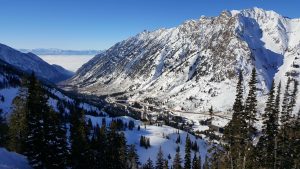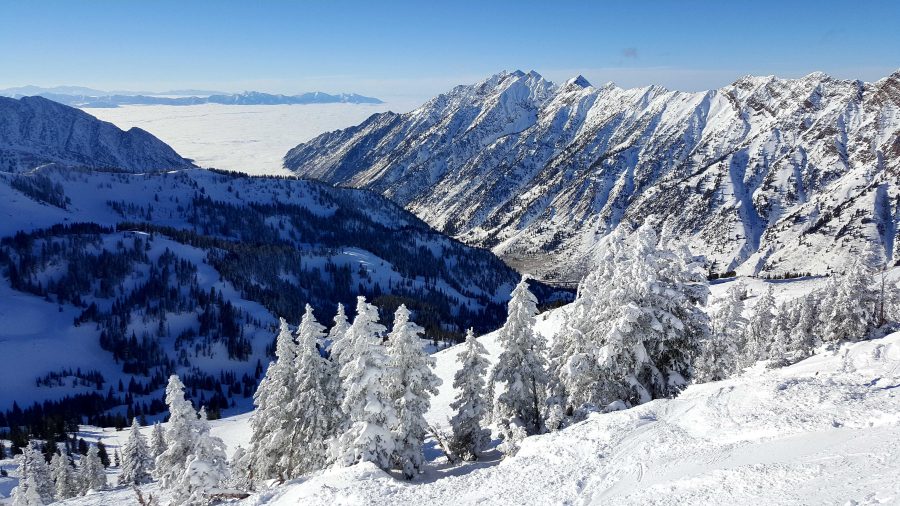Whether you enjoy hitting the slopes or just appreciate a healthy environment here in Utah, there is a threat to those enjoyments that might not be on your radar. We’re talking about dust.
Dr. McKenzie Skiles, assistant professor of geography at the University of Utah, is the lead author of a study focused on the impacts of dust deposition on snowmelt. The study was published online in the journal Environmental Research Letters on December 21.
Skiles has been studying the impact of dust on snow for over 10 years and has been taking measurements for the study since 2017 at an alpine study plot in Alta, Utah in the Wasatch Mountains. For the first time, dust in the air and in the snow was measured simultaneously. Skiles and her team found several dust storms and were able to model where the dust had originated using computer simulations. Results indicated that for the largest observed dust event, the dry lake bed of the Great Salt Lake was one of main dust sources, accounting for about 10 percent of deposited dust.
“Especially here in Utah,” Skiles said, “the mountain snowpack is really important— for both hydrology we get most of our water from snow— and for the economy, snow sports are really important for Salt Lake City area, so it’s really important to understand what controls snow accumulation and melt.”
Skiles chose to teach at the U because it was close to ski slopes. “Like many others, I came to Utah to ski, but no one wants to ski on dirty snow.”
“One of the things that has played an important role in snowmelt patterns particularly in the Western United States is deposition of dark particles,” Skiles said. “Dust and other aerosols that can come from human activity, such as black carbon or soot. We know that snow cover patterns are changing, we know that there is less snow-covered area and there might be less total water held in the snowpack.”
Skiles offers several reasons as to why understanding what controls snowmelt is important. “Eighty percent of the surface water for Salt Lake City comes from snowmelt and we don’t have a lot of storage along streams, so snowmelt is what controls immediate water availability and long-term water resources. Currently, our snowmelt runoff models do not account for the impact of dust on snow, so that could lead to forecasting errors. There are even some feedbacks involved that could lead to less water coming out of the mountains.”

In an online article, Skiles said, “What’s important about the Great Salt Lake is that there are no water rights, no policy to maintain lake levels. As the lake declines, dust events are projected to become more frequent, and now one of the dust source regions is right next door. Could we do something about it by enacting policy that maintains a minimum lake level?”
Fourth-year biomedical engineering student Zach Barber is an ex-competitive big mountain “ski bum” who grew up skiing in the Wasatch. “I was always told that my home range was a microcosm; the quality and quantity of snow would stay relatively unchanged over the years despite obvious changes in climate on a global scale,” Barber said. “But even over the past few seasons there’s been obvious decline.”
He said, “I remember years ago when resorts were open through summer, and finally seeing this research puts things into perspective. With the recent controversy over the proposed Bear River project, which would lower the level of the Great Salt Lake and contribute even more to rapid snowmelt, I think everyone in Salt Lake needs to be mindful of events and policy that affects one of our most valuable ecological and economic resources.”
Skiles emphasized that “it is important to keep in a global context that dust on snow impacts not only the Wasatch— it impacts mountains globally and the amount of dust in the air has increased in the 20th century indicating that it is related to human activity. Human activities are creating more dust and that’s contributing earlier snowmelt.” Her research in the Wasatch helps other researchers to understand similar processes all over the globe.
Skiles is currently expanding her research into the broader Western United States, in Montana, Wyoming and across Utah. “We are interested in seeing if the impact of dust on snow is greater in other places. If dust isn’t what controls snowmelt, then what are the other factors that are contributing to changing snowmelt patterns?”
Co-authors of the study include Dr. Derek A. Mallia, Dr. A. Gannet Hallar, Dr. John C. Lin, Andrew Lambert and Ross Peterson in the U’s Department of Atmospheric Sciences and Steven Clark of the U Department of Geography.


